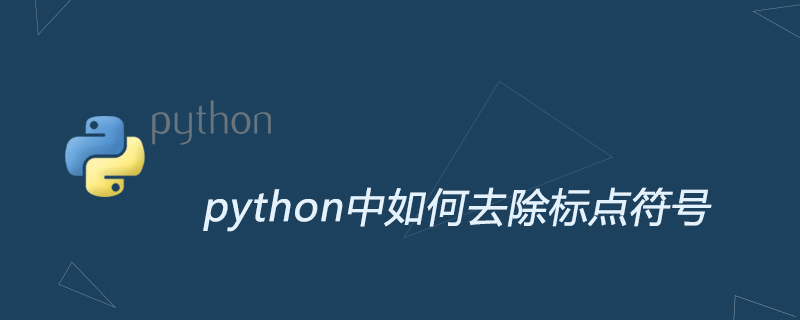Heim >Backend-Entwicklung >Python-Tutorial >So entfernen Sie Satzzeichen in Python

Die Methode zum Entfernen von Satzzeichen in Python ist wie folgt:
Methode 1:
str.isalnum:
S. isalnum() -> bool
Rückgabewert: True, wenn die Zeichenfolge mindestens ein Zeichen enthält und alle Zeichen Buchstaben oder Zahlen sind, andernfalls False.
Beispiel:
>>> string = "Special $#! characters spaces 888323" >>> ''.join(e for e in string if e.isalnum()) 'Specialcharactersspaces888323'
Kann nur Buchstaben und Zahlen erkennen, es ist sehr tödlich und tötet auch chinesische Schriftzeichen, Leerzeichen und dergleichen
Methode 2:
string.punctuation
import re, string
s ="string. With. Punctuation?" # Sample string
# 写法一:
out = s.translate(string.maketrans("",""), string.punctuation)
# 写法二:
out = s.translate(None, string.punctuation)
# 写法三:
exclude = set(string.punctuation)
out = ''.join(ch for ch in s if ch not in exclude)
# 写法四:
>>> for c in string.punctuation:
s = s.replace(c,"")
>>> s
'string With Punctuation'
# 写法五:
out = re.sub('[%s]' % re.escape(string.punctuation), '', s)
## re.escape:对字符串中所有可能被解释为正则运算符的字符进行转义
# 写法六:
# string.punctuation 只包括 ascii 格式; 想要一个包含更广(但是更慢)的方法是使用: unicodedata module :
from unicodedata import category
s = u'String — with - «Punctuation »...'
out = re.sub('[%s]' % re.escape(string.punctuation), '', s)
print 'Stripped', out
# 输出:u'Stripped String \u2014 with \xabPunctuation \xbb'
out = ''.join(ch for ch in s if category(ch)[0] != 'P')
print 'Stripped', out
# 输出:u'Stripped String with Punctuation '
# For Python 3 str or Python 2 unicode values, str.translate() only takes a dictionary; codepoints (integers) are looked up in that mapping and anything mapped to None is removed.
# To remove (some?) punctuation then, use:
import string
remove_punct_map = dict.fromkeys(map(ord, string.punctuation))
s.translate(remove_punct_map)
# Your method doesn't work in Python 3, as the translate method doesn't accept the second argument any more.
import unicodedata
import sys
tbl = dict.fromkeys(i for i in range(sys.maxunicode) if unicodedata.category(chr(i)).startswith('P'))
def remove_punctuation(text):
return text.translate(tbl)Methode 3:
re
Beispiel:
import re s ="string. With. Punctuation?" s = re.sub(r'[^\w\s]','',s)
Test:
import re, string, timeit
s ="string. With. Punctuation"
exclude = set(string.punctuation)
table = string.maketrans("","")
regex = re.compile('[%s]' % re.escape(string.punctuation))
def test_set(s):
return ''.join(ch for ch in s if ch not in exclude)
def test_re(s):
return regex.sub('', s)
def test_trans(s):
return s.translate(table, string.punctuation)
def test_repl(s):
for c in string.punctuation:
s=s.replace(c,"")
return s
print"sets :",timeit.Timer('f(s)', 'from __main__ import s,test_set as f').timeit(1000000)
print"regex :",timeit.Timer('f(s)', 'from __main__ import s,test_re as f').timeit(1000000)
print"translate :",timeit.Timer('f(s)', 'from __main__ import s,test_trans as f').timeit(1000000)
print"replace :",timeit.Timer('f(s)', 'from __main__ import s,test_repl as f').timeit(1000000)
out_put:
# sets : 19.8566138744
# regex : 6.86155414581
# translate : 2.12455511093
# replace : 28.4436721802Weitere technische Artikel zum Thema Python finden Sie in der Spalte Python-Tutorial, um mehr darüber zu erfahren!
Das obige ist der detaillierte Inhalt vonSo entfernen Sie Satzzeichen in Python. Für weitere Informationen folgen Sie bitte anderen verwandten Artikeln auf der PHP chinesischen Website!